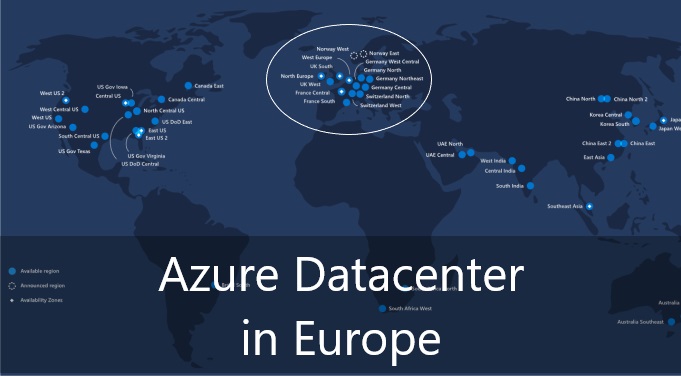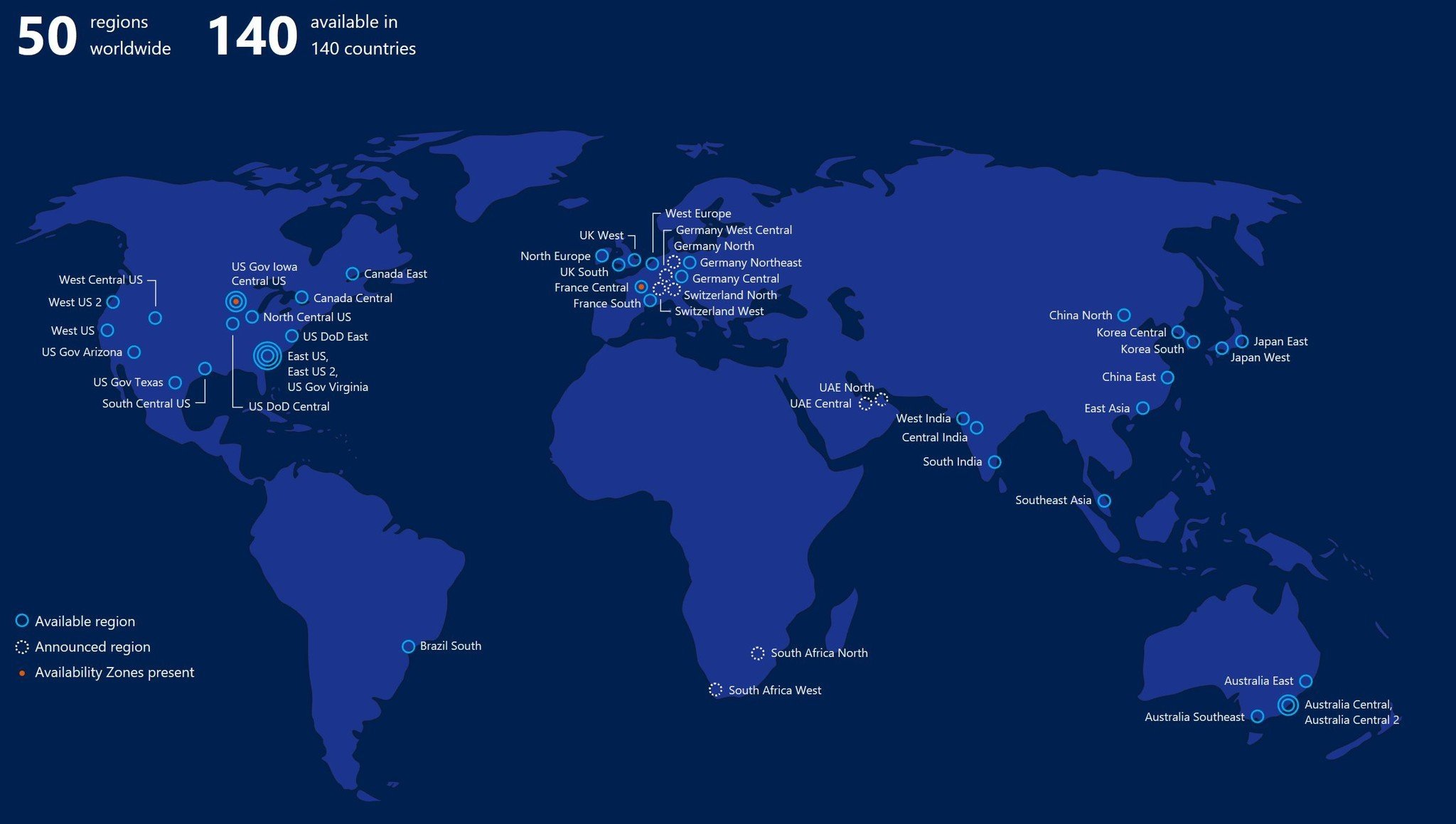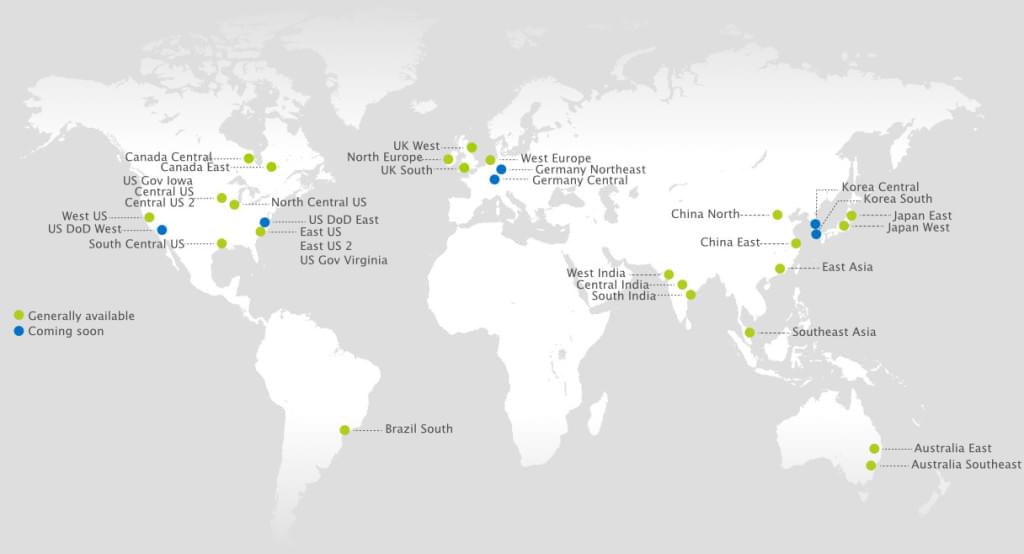What is Azure West Europe?
Azure West Europe is a region within Microsoft Azure’s cloud platform, specifically designed to cater to the needs of businesses and organizations operating in Western Europe. By choosing Azure West Europe, these entities can access a wide array of cloud services, ranging from virtual machines and databases to AI & machine learning capabilities, all aimed at enhancing their digital transformation journey. The significance of Azure West Europe lies in its ability to provide localized services, ensuring reduced latency, compliance with data privacy regulations, and seamless integration with existing infrastructure.
Key Features and Services of Azure West Europe
Azure West Europe offers a wide range of cloud services tailored to meet the diverse needs of businesses and organizations in Western Europe. Among the key features and services are:
- Virtual Machines: Azure West Europe provides scalable and secure virtual machines (VMs) that allow users to deploy Windows, Linux, and SQL Server VMs in minutes. These VMs can be customized to specific workload requirements, ensuring optimal performance and cost-efficiency.
- Databases: Azure West Europe supports various database services, including Azure SQL Database, Cosmos DB, and Azure Database for MySQL, PostgreSQL, and MariaDB. These services enable organizations to manage their databases with ease, while ensuring high availability, security, and performance.
- Storage: Azure West Europe offers robust storage solutions, such as Azure Blob Storage, Azure Files, and Azure Queues, which cater to various data storage needs. These solutions provide durability, scalability, and security, making them ideal for backup, archiving, and disaster recovery purposes.
- AI & Machine Learning: Azure West Europe’s AI and machine learning capabilities empower businesses to build, train, and deploy intelligent applications. Services like Azure Machine Learning, Azure Cognitive Services, and Azure Bot Service enable organizations to harness the power of AI and make data-driven decisions.
By leveraging these features and services, businesses and organizations in Western Europe can streamline their operations, reduce costs, and enhance their competitive edge. The potential impact of using Azure West Europe services includes improved productivity, increased agility, and better customer experiences.
How to Set Up and Utilize Azure West Europe
To start using Azure West Europe services, follow these steps:
- Create an Azure account: Visit the Azure website and click on the “Start free” button to create a new account. You will need to provide your email address, phone number, and credit card information. Note that you can use the free tier for testing and evaluation purposes.
- Log in to the Azure portal: After creating your account, log in to the Azure portal using your credentials. The portal provides a user-friendly interface for managing Azure resources and services.
- Select the Azure West Europe region: In the Azure portal, click on the “Create a resource” button to start creating new resources. Make sure to select “West Europe” as the region when configuring your resources. This ensures that your data and applications will be hosted in the West Europe data centers.
- Choose the appropriate services: Azure West Europe offers a wide range of services, including virtual machines, databases, storage, and AI & machine learning capabilities. Select the services that best fit your business needs and requirements.
- Configure settings: After selecting the desired services, configure the necessary settings, such as instance size, storage capacity, and network configurations. Make sure to follow best practices for security, cost optimization, and performance tuning.
- Deploy and monitor: Once you have configured your resources, deploy them and start monitoring their performance. Use Azure monitoring tools, like Azure Monitor and Azure Log Analytics, to track resource health, identify issues, and optimize performance.
By following these steps, you can easily set up and start using Azure West Europe services. Remember to choose the right services, configure them appropriately, and continuously monitor their performance to ensure optimal results.
Best Practices for Azure West Europe Deployment
To ensure successful deployment and management of Azure West Europe services, consider the following best practices:
- Security: Implement strong security measures, such as multi-factor authentication, encryption, and network segmentation. Regularly monitor security logs and respond to security alerts to maintain a secure environment.
- Cost optimization: Utilize Azure cost management tools to monitor and optimize your spending. Consider reserved instances, spot instances, and Azure Hybrid Benefit to reduce costs. Schedule automatic shutdowns for non-production environments to minimize expenses.
- Performance tuning: Monitor resource usage and performance metrics to identify bottlenecks and optimize resource configurations. Use Azure Autoscale to automatically adjust resources based on demand, ensuring optimal performance and cost-efficiency.
- Disaster recovery: Implement Azure Site Recovery to replicate workloads between Azure regions or on-premises environments. Regularly test disaster recovery plans to ensure quick and efficient failover and minimize downtime.
- Regional compliance: Ensure that your Azure West Europe deployment complies with regional data privacy regulations, such as the General Data Protection Regulation (GDPR). Use Azure Policy to enforce compliance and monitor compliance status regularly.
- Backup and restore: Schedule regular backups for critical resources and configure retention policies to ensure data availability. Use Azure Backup to restore data in case of data loss or corruption.
By following these best practices, you can ensure a successful deployment and management of Azure West Europe services, maximizing their potential impact on your business operations.
Real-World Applications and Success Stories of Azure West Europe
Azure West Europe has empowered numerous businesses and organizations in Western Europe to achieve their goals and overcome challenges. Here are a few success stories:
Case Study 1: A Large Retail Chain
A major retail chain in Western Europe leveraged Azure West Europe to modernize its IT infrastructure and improve customer experiences. By utilizing Azure virtual machines, databases, and AI & machine learning capabilities, the retailer was able to:
- Implement real-time inventory management and demand forecasting, reducing stockouts and overstocks.
- Personalize customer experiences through AI-powered product recommendations and targeted marketing campaigns.
- Enhance security and compliance by utilizing Azure security services and multi-factor authentication.
Case Study 2: A Public Sector Organization
A public sector organization in Western Europe used Azure West Europe to streamline its operations and improve service delivery. By adopting Azure storage, virtual machines, and database services, the organization was able to:
- Digitize records and enable secure, remote access to critical documents and data.
- Improve collaboration and productivity through Azure-powered communication and collaboration tools.
- Ensure data privacy and compliance with regional regulations using Azure security and compliance features.
These success stories demonstrate the transformative potential of Azure West Europe services for businesses and organizations in Western Europe. By leveraging Azure’s offerings, these entities can improve operational efficiency, enhance customer experiences, and maintain a competitive edge in their respective industries.
Comparing Azure West Europe to Other Azure Regions
Azure West Europe is one of many regions available in the Microsoft Azure cloud platform. Each region offers unique advantages and disadvantages, depending on factors such as latency, data privacy, and regional compliance requirements. Here’s a comparison of Azure West Europe to other Azure regions:
Azure North Europe
Azure North Europe, located in Dublin, Ireland, is another popular region for Western European customers. Both Azure West Europe and Azure North Europe offer similar services and features. The primary difference lies in latency, with Azure North Europe generally providing lower latency for customers in Ireland, the United Kingdom, and northern Europe.
Azure West Central US
Azure West Central US, located in Iowa, USA, is a suitable option for Western European customers looking to expand their operations into the United States. While this region offers similar services and features, customers should consider factors such as data privacy regulations and cross-border data transfer costs.
Azure Southeast Asia
Azure Southeast Asia, located in Singapore, is an ideal region for Western European customers looking to target the Asian market. This region offers similar services and features, but customers should consider factors such as data privacy regulations, regional compliance requirements, and cross-border data transfer costs.
When choosing an Azure region, consider factors such as latency, data privacy, and regional compliance requirements. Azure West Europe is a suitable option for Western European customers, but other regions may provide unique advantages depending on your specific needs and goals.
Staying Up-to-Date with Azure West Europe Developments
To stay informed about the latest Azure West Europe developments, follow these resources:
Azure Documentation
The official Azure documentation is a comprehensive resource that covers all aspects of Azure services, including Azure West Europe. Regularly check the documentation for updates on services, features, and best practices.
Azure Blogs
The Azure blog is a valuable resource for staying up-to-date on Azure news, announcements, and updates. Subscribe to the Azure blog to receive notifications about new posts and updates related to Azure West Europe.
Azure Community Forums
The Azure community forums are a great place to connect with other Azure users, ask questions, and share knowledge. Join the Azure West Europe forum to stay informed about regional-specific developments and engage in discussions with other users.
Azure Release Notes
Azure release notes provide detailed information about updates, bug fixes, and new features for Azure services. Regularly check the Azure release notes to stay informed about changes and updates related to Azure West Europe.
Azure Events and Webinars
Microsoft hosts various events and webinars throughout the year, covering a wide range of Azure-related topics. Attend Azure events and webinars to learn about new developments, features, and best practices related to Azure West Europe.
By utilizing these resources, you can stay informed about the latest Azure West Europe developments, ensuring that you’re always up-to-date on the latest services, features, and best practices.
Overcoming Challenges and Troubleshooting Azure West Europe Issues
When using Azure West Europe services, you may encounter various challenges and issues. Here are some common problems and potential solutions:
Service Disruptions
Service disruptions can occur due to maintenance, upgrades, or unforeseen circumstances. To stay informed about service disruptions, regularly check the Azure Service Health dashboard. This dashboard provides real-time updates on the status of Azure services, including Azure West Europe.
Performance Degradation
Performance degradation can occur due to various factors, such as resource contention, network issues, or configuration problems. To troubleshoot performance degradation, use Azure Monitor and Azure Log Analytics to identify the root cause and implement performance tuning techniques, such as scaling up or out, optimizing resource configurations, or adjusting network settings.
Billing Discrepancies
Billing discrepancies can occur due to incorrect resource configurations, usage estimates, or pricing calculations. To troubleshoot billing discrepancies, use the Azure Cost Management tool to analyze your usage and costs, identify any discrepancies, and implement cost optimization strategies, such as reserving instances, using spot instances, or scheduling automatic shutdowns for non-production environments.
Security Vulnerabilities
Security vulnerabilities can occur due to misconfigured resources, outdated software, or insufficient security measures. To mitigate security vulnerabilities, implement best practices such as enabling multi-factor authentication, encrypting data at rest and in transit, implementing network segmentation, and regularly monitoring security logs and alerts.
By following these troubleshooting tips and best practices, you can overcome common challenges and issues when using Azure West Europe services, ensuring optimal performance, security, and cost-efficiency.




